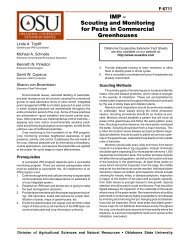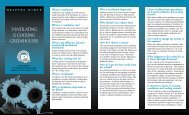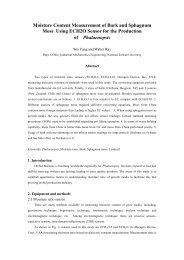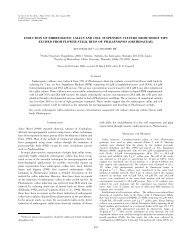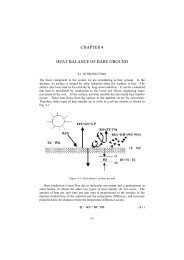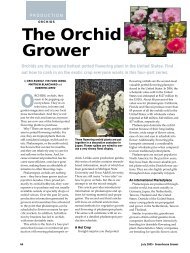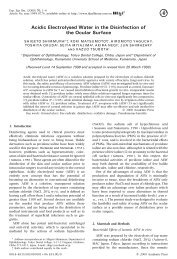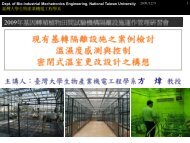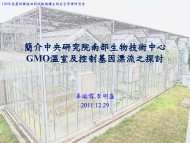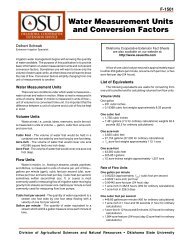effect of utilizing evaporative cooling in tiestall dairy barns equipped ...
effect of utilizing evaporative cooling in tiestall dairy barns equipped ...
effect of utilizing evaporative cooling in tiestall dairy barns equipped ...
You also want an ePaper? Increase the reach of your titles
YUMPU automatically turns print PDFs into web optimized ePapers that Google loves.
This is not a peer-reviewed article.Pp. 312-319 <strong>in</strong> Fifth International Dairy Hous<strong>in</strong>g Proceed<strong>in</strong>gs <strong>of</strong> the 29-31 January 2003Conference (Fort Worth, Texas USA) Publication Date 29 January 2003.ASAE Publication Number 701P0203, ed. Kev<strong>in</strong> JanniEFFECT OF UTILIZING EVAPORATIVE COOLING IN TIESTALL DAIRYBARNS EQUIPPED WITH TUNNEL VENTILATION ON RESPIRATIONRATES AND BODY TEMPERATURE OF LACTATING DAIRY CATTLEM.J. Brouk 1 , J.F. Smith 2 and J.P. Harner, III 3ABSTRACTDur<strong>in</strong>g the summer <strong>of</strong> 2001, six tie-stall <strong>dairy</strong> <strong>barns</strong> <strong>in</strong> northeast Missouri were monitored todeterm<strong>in</strong>e the <strong>effect</strong>s <strong>of</strong> <strong>evaporative</strong> <strong>cool<strong>in</strong>g</strong> on the environment, respiration rate and bodytemperature <strong>of</strong> lactat<strong>in</strong>g <strong>dairy</strong> cattle housed <strong>in</strong> <strong>barns</strong> <strong>equipped</strong> with tunnel ventilation.Temperature and relative humidity were cont<strong>in</strong>uously monitored and recorded every 15 m<strong>in</strong>utes <strong>in</strong>six <strong>barns</strong> (3 with and 3 without <strong>evaporative</strong> <strong>cool<strong>in</strong>g</strong> systems) for a three-month period.Temperature and relative humidity data were averaged by hour prior to statistical analysis.Respiration rate, <strong>in</strong>frared sk<strong>in</strong> temperature and rectal body temperature <strong>of</strong> 20 animals per barn (10primiparous and 10 multiparious) were measured on three different days dur<strong>in</strong>g summer heatstress. Measurements were simultaneously taken between 7-8 am, 4-5 pm and 10-11 pm on each<strong>of</strong> the three days. Cattle housed <strong>in</strong> <strong>evaporative</strong> cooled tunnel ventilated <strong>barns</strong> had lower (P
non-<strong>evaporative</strong> methods and 75% is lost via moisture evaporation from the sk<strong>in</strong> and the lungs. Astemperature cont<strong>in</strong>ues to <strong>in</strong>crease above 27 °F, a greater percentage <strong>of</strong> heat is lost via the sk<strong>in</strong> andlungs and a much smaller portion through non-<strong>evaporative</strong> methods (Kibler, 1950).When choos<strong>in</strong>g heat abatement measures, it is important to remember these concepts. There aretwo general approaches to <strong>cool<strong>in</strong>g</strong> <strong>dairy</strong> cattle. One must either modify the environment toprevent heat stress or implement methods that <strong>in</strong>crease heat dissipation from the sk<strong>in</strong> <strong>of</strong> cattle. Aircondition<strong>in</strong>g is the ultimate method to modify a warm environment. It reduces air temperature andrelative humidity lower<strong>in</strong>g the THI <strong>of</strong> the environment below thermally stressful levels. On acommercial basis, this is not an economical choice for modify<strong>in</strong>g the environment <strong>of</strong> <strong>dairy</strong> cattle.A more economical method to reduce air temperature is by <strong>evaporative</strong> <strong>cool<strong>in</strong>g</strong>. When waterevaporates it absorbs heat, reduc<strong>in</strong>g the air temperature. When water evaporates it also <strong>in</strong>creasesthe relative humidity due to the <strong>in</strong>creased level <strong>of</strong> water vapor present.Tunnel ventilation comb<strong>in</strong>ed with <strong>evaporative</strong> <strong>cool<strong>in</strong>g</strong> systems has been used <strong>in</strong> sw<strong>in</strong>e and poultryoperations for many years to cool the environment. Recently, these systems have been <strong>in</strong>stalled <strong>in</strong>some Midwest <strong>dairy</strong> facilities. It has been reported (Huhnke et al., 2001) that <strong>evaporative</strong> <strong>cool<strong>in</strong>g</strong>can reduce the number <strong>of</strong> hours at higher temperature-humidity <strong>in</strong>dex (THI) levels <strong>in</strong> someenvironments. Evaporative <strong>cool<strong>in</strong>g</strong> is used very successfully to cool <strong>dairy</strong> cattle <strong>in</strong> hot aridclimates. Under arid conditions and high environmental temperatures, there is a great potential toreduce the air temperature and THI (Figures 1 and 2) by evaporation. However, as relativehumidity <strong>in</strong>creases and or air temperature decreases, the potential <strong>of</strong> <strong>evaporative</strong> <strong>cool<strong>in</strong>g</strong> to modifythe environment decreases. Data presented <strong>in</strong> Figures 1 and 2 are based on a 100% <strong>evaporative</strong>efficiency and br<strong>in</strong>g air to 90% relative humidity. The efficiency <strong>of</strong> <strong>evaporative</strong> <strong>cool<strong>in</strong>g</strong>equipment ranges between 50 and 80%, which reduces the <strong>effect</strong> <strong>of</strong> the systems. In the Midwest,high relative humidity reduces the potential <strong>of</strong> <strong>evaporative</strong> <strong>cool<strong>in</strong>g</strong>. As relative humidity <strong>in</strong>creasesabove 70%, the potential reduction <strong>in</strong> THI is less than 10%. Data collected from <strong>dairy</strong> facilitieslocated <strong>in</strong> Kansas and Nebraska (Table 1) showed a slight reduction <strong>in</strong> the percentage <strong>of</strong> hoursabove a THI <strong>of</strong> 75 (Brouk, et al., 1999). Data from 2000 were collected <strong>utiliz<strong>in</strong>g</strong> similarprocedures to the 1999 data. This may have been due to <strong>in</strong><strong>effect</strong>ive design, ambient conditions ora comb<strong>in</strong>ation <strong>of</strong> bothVery few studies reported <strong>in</strong> the literature describe the <strong>effect</strong>s <strong>of</strong> <strong>evaporative</strong> <strong>cool<strong>in</strong>g</strong> on the stresslevel <strong>of</strong> <strong>dairy</strong> cattle housed <strong>in</strong> humid environments. Brown et al., (1974) evaluated the <strong>effect</strong>s <strong>of</strong><strong>evaporative</strong> <strong>cool<strong>in</strong>g</strong> <strong>in</strong> tie stall hous<strong>in</strong>g at Mississippi State University dur<strong>in</strong>g the summers <strong>of</strong>1970, 1971 and 1972. Milk production was significantly <strong>in</strong>creased <strong>in</strong> one <strong>of</strong> the three summersand respiration rates were significantly lowered <strong>in</strong> two <strong>of</strong> three summers by <strong>evaporative</strong> <strong>cool<strong>in</strong>g</strong> ascompared to the controls. The study showed that <strong>evaporative</strong> <strong>cool<strong>in</strong>g</strong> could reduce peak daytimetemperatures however the authors questioned the long term benefits <strong>of</strong> the system.MATERIALS AND METHODSDur<strong>in</strong>g the summer <strong>of</strong> 2001 six tunnel ventilated tie stall <strong>barns</strong> <strong>in</strong> northeastern Missouri andsoutheastern Iowa were evaluated. Three <strong>of</strong> the <strong>barns</strong> were <strong>equipped</strong> with cellulose <strong>evaporative</strong>pads and three were not. Temperature and relative humidity were recorded cont<strong>in</strong>uously for 11weeks from July 1 to September 15, 2001 us<strong>in</strong>g data loggers( HOBO® H8 Pro RH/TemperatureLogger, OnSet Computer Corp. Bourne, MA) On three consecutive days under stress conditions,respiration rates, rectal temperature, and sk<strong>in</strong> temperature <strong>of</strong> three sites were evaluated on 20 cows<strong>in</strong> each barn. Sk<strong>in</strong> temperature <strong>of</strong> the rear udder, shoulder at the base <strong>of</strong> the ear was measuredus<strong>in</strong>g a <strong>in</strong>frared temperature gun (Raytek® Raynger® MX model RayMX4KM98, Santa Cruz,CA). Evaporative <strong>cool<strong>in</strong>g</strong> was only utilized from approximately 10:00 am until 9:00 pm <strong>in</strong> the<strong>barns</strong> <strong>equipped</strong> with <strong>evaporative</strong> pads. Respiration and temperature data were averaged by day,time and barn prior to analysis. Data were then subjected to a replicated design analysis.1
RESULTS AND DISCUSSIONCattle housed <strong>in</strong> tie stall <strong>barns</strong> <strong>equipped</strong> with <strong>evaporative</strong> <strong>cool<strong>in</strong>g</strong> had lower average respirationrates (65.7 vs 70.3 breaths/m<strong>in</strong>) than those housed <strong>in</strong> <strong>barns</strong> without <strong>evaporative</strong> <strong>cool<strong>in</strong>g</strong> (Table 2).However, rates observed <strong>in</strong> the morn<strong>in</strong>g and at night were not different, only the afternoon ratesdiffered significantly. Average rectal temperatures were also lower for the cows housed <strong>in</strong><strong>evaporative</strong> cooled <strong>barns</strong>. Similar to respiration rates, the greatest differences existed dur<strong>in</strong>g theafternoon. Sk<strong>in</strong> temperatures followed respiration rates and rectal temperatures and weresignificantly lower for the cattle housed <strong>in</strong> the <strong>barns</strong> <strong>equipped</strong> with <strong>evaporative</strong> <strong>cool<strong>in</strong>g</strong> with thegreatest differences observed dur<strong>in</strong>g the afternoon.Changes <strong>in</strong> barn environment for <strong>evaporative</strong> cooled and tunnel ventilated <strong>barns</strong> are shown <strong>in</strong>Figures 3, 4 and 5. Greatest changes from ambient conditions are noted dur<strong>in</strong>g the 1:00 pm to 8:00pm period. Dur<strong>in</strong>g this period temperature decreases up to 4.6ºC, relative humidity <strong>in</strong>creases up to30% and THI decreases up to 3.25 units as compared to the ambient conditions. There isconsiderable variation <strong>in</strong> the response over the 11 wk trial. Dur<strong>in</strong>g the period from 9:00 pm to4:00 am and the period from 5:00 am to 12:00 pm, the <strong>evaporative</strong> pads were not utilized due tothe ambient humidity level reach<strong>in</strong>g about 85%. Thus the systems had little <strong>effect</strong> upon the barnenvironment dur<strong>in</strong>g these periods.As compared to the <strong>barns</strong> with only tunnel ventilation, <strong>barns</strong> with <strong>evaporative</strong> <strong>cool<strong>in</strong>g</strong> had agreater percentage <strong>of</strong> July and August hours at a THI level below 70 and elim<strong>in</strong>ated the hours <strong>in</strong>the 85-90 THI category (Figure 6) dur<strong>in</strong>g the hours <strong>of</strong> 1:00 pm and 8:00 pm. Evaporative <strong>cool<strong>in</strong>g</strong>reduced the heat stress dur<strong>in</strong>g the afternoon hours without <strong>in</strong>creas<strong>in</strong>g the stress dur<strong>in</strong>g the even<strong>in</strong>gand night hours as compared to the tunnel ventilated <strong>barns</strong>. This study showed significantadvantages for the <strong>evaporative</strong> cooled and tunnel ventilated <strong>barns</strong> <strong>in</strong> terms <strong>of</strong> respiration rates,rectal temperatures and barn environment.Can <strong>evaporative</strong> <strong>cool<strong>in</strong>g</strong> be utilized <strong>in</strong> comb<strong>in</strong>ation with tunnel ventilation to reduce heat stress <strong>of</strong><strong>dairy</strong> cattle housed <strong>in</strong> the Midwest? It depends upon several factors. First, what is the ambient orenvironmental air temperature and evaporation potential? In many locations, the afternoon relativehumidity may be too great to take advantage <strong>of</strong> <strong>evaporative</strong> <strong>cool<strong>in</strong>g</strong>. In the 2001 study area,nighttime relative humidity level was near the saturation po<strong>in</strong>t, limit<strong>in</strong>g the system’s evaporationpotential. However, afternoon relative humidity levels dropped enough to have sufficientevaporation potential to make the systems <strong>effect</strong>ive reduc<strong>in</strong>g severe heat stress. In hot aridconditions, the system would work well. However, <strong>in</strong> high humidity locations its <strong>effect</strong>ivenesswould be limited because the evaporation potential would be decreased.If the environment has sufficient evaporation potential, one should then consider barn design. The<strong>barns</strong> studied <strong>in</strong> 2001 were well designed and had a small cross-sectional area. This allowed forhigh levels <strong>of</strong> air exchanged with m<strong>in</strong>imal fan horsepower. These <strong>barns</strong> were also less than 91m <strong>in</strong>length and approximately 12 m wide with ceil<strong>in</strong>g heights <strong>of</strong> less than 3 m. All <strong>barns</strong> also hadsufficient <strong>evaporative</strong> <strong>cool<strong>in</strong>g</strong> pad area. These systems were utilized dur<strong>in</strong>g the afternoon hoursand were shut down dur<strong>in</strong>g the high humidity even<strong>in</strong>g and night hours. The net <strong>effect</strong> was areduction <strong>in</strong> animal stress as compared to tunnel ventilation only. When sound design criteria arenot followed, problems arise as was noted <strong>in</strong> the 1999 study. Based on the 2000 data, there may besome advantages <strong>of</strong> the <strong>evaporative</strong> system <strong>in</strong> smaller <strong>barns</strong> as compared to large freestall <strong>barns</strong>.Smaller <strong>barns</strong> (tie stall) have a much smaller cross-sectional area than a large freestall barn. If onebuilds a barn with 3.7 m side-walls and a 4/12 ro<strong>of</strong> pitch, over 25% <strong>of</strong> the cross-sectional area isthe rafter area. One approach is to utilize a ceil<strong>in</strong>g or false ceil<strong>in</strong>g along underside <strong>of</strong> the rafters toreduce the cross-sectional area that is tunnel ventilated and <strong>evaporative</strong> cooled. It would also bepossible to lower the sidewall height and ro<strong>of</strong> pitch, which would require that the structure alwaysbe mechanically ventilated. This approach has been taken <strong>in</strong> the sw<strong>in</strong>e <strong>in</strong>dustry. Try<strong>in</strong>g to mixnatural and mechanical ventilation systems has had limited success <strong>in</strong> the sw<strong>in</strong>e <strong>in</strong>dustry and thesame is likely <strong>in</strong> the <strong>dairy</strong> <strong>in</strong>dustry. To work <strong>effect</strong>ively, <strong>evaporative</strong> <strong>cool<strong>in</strong>g</strong> and tunnel2
ventilation systems must be correctly designed. Suggested guidel<strong>in</strong>es to tunnel ventilation havebeen made by Tyson et al., (1998).The third th<strong>in</strong>g to consider is the <strong>effect</strong>iveness <strong>of</strong> <strong>evaporative</strong> <strong>cool<strong>in</strong>g</strong> with other heat abatementmethods. Work at KSU has shown the <strong>effect</strong>iveness <strong>of</strong> soak<strong>in</strong>g cattle and then evaporat<strong>in</strong>g thewater from sk<strong>in</strong>. This has been shown to be highly <strong>effect</strong>ive <strong>in</strong> reduc<strong>in</strong>g respiration rates and sk<strong>in</strong>temperatures. However, to date no study has evaluated <strong>in</strong> a head-to-head comparison the <strong>effect</strong> <strong>of</strong><strong>evaporative</strong> <strong>cool<strong>in</strong>g</strong> verses soak<strong>in</strong>g and evaporation from the sk<strong>in</strong> surface. It would be moreefficient to dissipate heat from the sk<strong>in</strong> via evaporation rather than exchange via convection.However additional research is needed to determ<strong>in</strong>e the <strong>effect</strong>s <strong>of</strong> tunnel and <strong>evaporative</strong> <strong>cool<strong>in</strong>g</strong>systems on milk production as compared to conventional methods <strong>of</strong> cow <strong>cool<strong>in</strong>g</strong>.CONCLUSIONSEvaporative <strong>cool<strong>in</strong>g</strong> <strong>in</strong> conjunction with tunnel ventilation reduced afternoon heat stress <strong>of</strong> <strong>dairy</strong>cattle housed <strong>in</strong> tie-stall <strong>barns</strong> as compared to tunnel ventilation alone. Cattle housed <strong>in</strong> <strong>barns</strong>with <strong>evaporative</strong> <strong>cool<strong>in</strong>g</strong> had lower (P
2520Decrease <strong>in</strong>Temperature, o C1510543.337.832.226.721.1010 20 30 40 50 60 70 80Relative Humidity, %Figure 1. Potential change <strong>in</strong> air temperature due to <strong>evaporative</strong> <strong>cool<strong>in</strong>g</strong> at various levels <strong>of</strong> ambienttemperature and relative humidity.45403530THI Change25201510543.337.832.226.721.1010 20 30 40 50 60 70 80Relative Humidity, %Figure 2. Potential Temperature-humidity <strong>in</strong>dex change due to <strong>evaporative</strong> <strong>cool<strong>in</strong>g</strong> at various levels <strong>of</strong> ambientair temperature and relative humidity.5
TemperatureDifference, O C (Barn -Ambient)210-1-2-3-4-51 2 3 4 5 6 7 8 9 10 11Week <strong>of</strong> StudyPeriod 1 ( 9 pm - 4 am )Period 2 ( 5 am - 12 pm )Period 3 ( 1 pm - 8 pm )Figure 3. Effect <strong>of</strong> <strong>evaporative</strong> <strong>cool<strong>in</strong>g</strong> on temperature difference (barn-ambient dur<strong>in</strong>g three different period<strong>of</strong> the day <strong>in</strong> ties-tall <strong>barns</strong> dur<strong>in</strong>g the summer <strong>of</strong> 2001.Relative HumidityDifference(Barn - Ambient)35302520151050-51 2 3 4 5 6 7 8 9 10 11Week <strong>of</strong> StudyPeriod 1 ( 9 pm - 4 am )Period 2 ( 5 am - 12 pm )Period 3 ( 1 pm - 8 pm )Figure 4. Effect <strong>of</strong> <strong>evaporative</strong> <strong>cool<strong>in</strong>g</strong> on relative humidity difference (barn-ambient) dur<strong>in</strong>g three differentperiods <strong>of</strong> the day <strong>in</strong> tie-stall <strong>barns</strong> dur<strong>in</strong>g the summer <strong>of</strong> 2001.6
THI Difference(Barn - Ambient)3210-1-2-3-41 2 3 4 5 6 7 8 9 10 11Week <strong>of</strong> StudyPeriod 1 ( 9 pm - 4 am )Period 2 ( 5 am - 12 pm )Period 3 ( 1 pm - 8 pm )Figure 5. Effect <strong>of</strong> <strong>evaporative</strong> <strong>cool<strong>in</strong>g</strong> on temperature-humidity <strong>in</strong>dex difference (barn-ambient) dur<strong>in</strong>g threedifferent periods <strong>of</strong> the day <strong>in</strong> tie-stall barn dur<strong>in</strong>g the summer <strong>of</strong> 2001.4035% <strong>of</strong> TotalHours30252015105



